Process step evaluation-制程评估
- 格式:pdf
- 大小:94.54 KB
- 文档页数:5
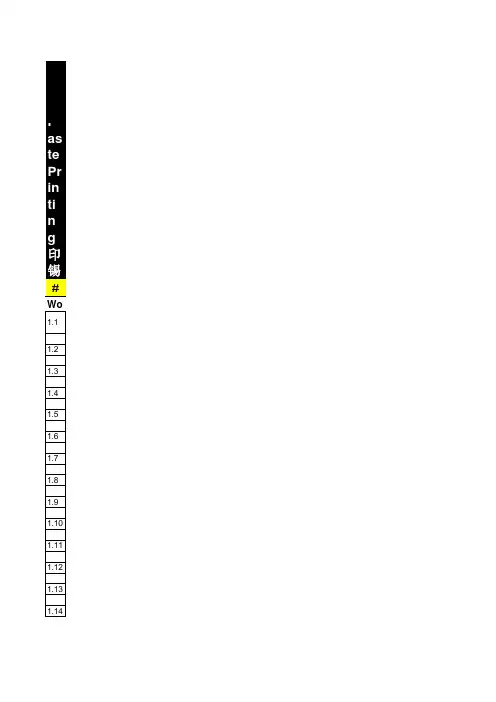
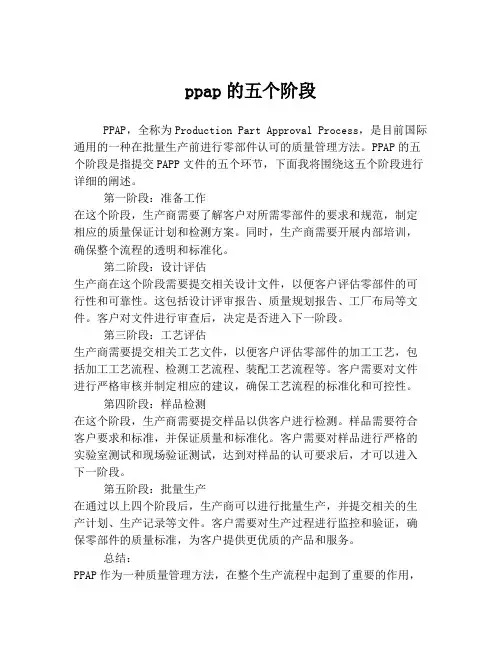
ppap的五个阶段PPAP,全称为Production Part Approval Process,是目前国际通用的一种在批量生产前进行零部件认可的质量管理方法。
PPAP的五个阶段是指提交PAPP文件的五个环节,下面我将围绕这五个阶段进行详细的阐述。
第一阶段:准备工作在这个阶段,生产商需要了解客户对所需零部件的要求和规范,制定相应的质量保证计划和检测方案。
同时,生产商需要开展内部培训,确保整个流程的透明和标准化。
第二阶段:设计评估生产商在这个阶段需要提交相关设计文件,以便客户评估零部件的可行性和可靠性。
这包括设计评审报告、质量规划报告、工厂布局等文件。
客户对文件进行审查后,决定是否进入下一阶段。
第三阶段:工艺评估生产商需要提交相关工艺文件,以便客户评估零部件的加工工艺,包括加工工艺流程、检测工艺流程、装配工艺流程等。
客户需要对文件进行严格审核并制定相应的建议,确保工艺流程的标准化和可控性。
第四阶段:样品检测在这个阶段,生产商需要提交样品以供客户进行检测。
样品需要符合客户要求和标准,并保证质量和标准化。
客户需要对样品进行严格的实验室测试和现场验证测试,达到对样品的认可要求后,才可以进入下一阶段。
第五阶段:批量生产在通过以上四个阶段后,生产商可以进行批量生产,并提交相关的生产计划、生产记录等文件。
客户需要对生产过程进行监控和验证,确保零部件的质量标准,为客户提供更优质的产品和服务。
总结:PPAP作为一种质量管理方法,在整个生产流程中起到了重要的作用,保证了商品的质量和标准化。
PPAP的五个阶段是在各个方面保证了生产质量和管理的科学性,生产商和客户都需要严格执行PPAP五个阶段的要求,确保生产的质量和标准化,满足客户对商品质量和标准化的严格要求。
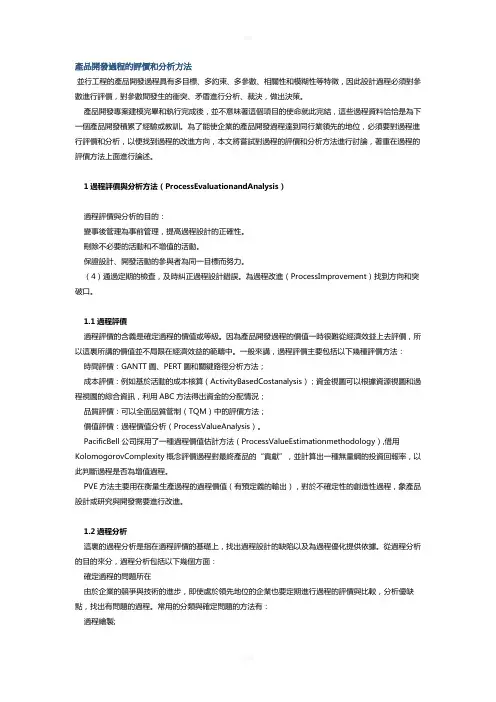
產品開發過程的評價和分析方法並行工程的產品開發過程具有多目標、多約束、多參數、相關性和模糊性等特徵,因此設計過程必須對參數進行評價,對參數間發生的衝突、矛盾進行分析、裁決,做出決策。
產品開發專案建模完畢和執行完成後,並不意味著這個項目的使命就此完結,這些過程資料恰恰是為下一個產品開發積累了經驗或教訓。
為了能使企業的產品開發過程達到同行業領先的地位,必須要對過程進行評價和分析,以便找到過程的改進方向,本文將嘗試對過程的評價和分析方法進行討論,著重在過程的評價方法上面進行論述。
1過程評價與分析方法(ProcessEvaluationandAnalysis)過程評價與分析的目的:變事後管理為事前管理,提高過程設計的正確性。
刪除不必要的活動和不增值的活動。
保證設計、開發活動的參與者為同一目標而努力。
(4)通過定期的檢查,及時糾正過程設計錯誤。
為過程改進(ProcessImprovement)找到方向和突破口。
1.1過程評價過程評價的含義是確定過程的價值或等級。
因為產品開發過程的價值一時很難從經濟效益上去評價,所以這裏所講的價值並不局限在經濟效益的範疇中。
一般來講,過程評價主要包括以下幾種評價方法:時間評價:GANTT圖、PERT圖和關鍵路徑分析方法;成本評價:例如基於活動的成本核算(ActivityBasedCostanalysis);資金視圖可以根據資源視圖和過程視圖的綜合資訊,利用ABC方法得出資金的分配情況;品質評價:可以全面品質管制(TQM)中的評價方法;價值評價:過程價值分析(ProcessValueAnalysis)。
PacificBell公司採用了一種過程價值估計方法(ProcessValueEstimationmethodology),借用KolomogorovComplexity概念評價過程對最終產品的“貢獻”,並計算出一種無量綱的投資回報率,以此判斷過程是否為增值過程。
PVE方法主要用在衡量生產過程的過程價值(有預定義的輸出),對於不確定性的創造性過程,象產品設計或研究與開發需要進行改進。
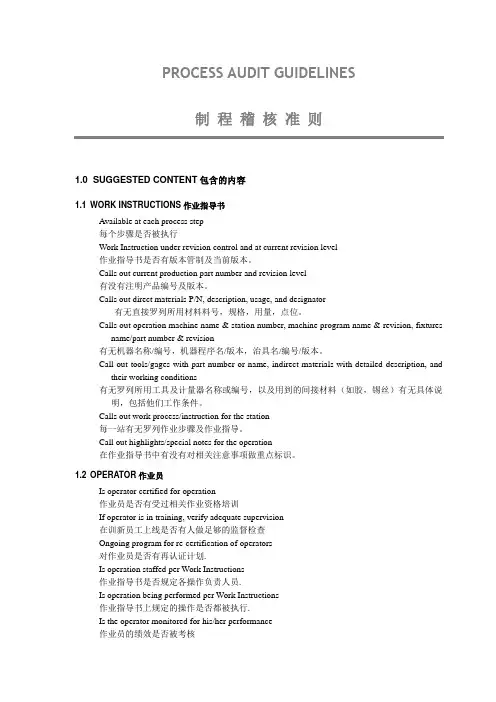
PROCESS AUDIT GUIDELINES制程稽核准则1.0 SUGGESTED CONTENT包含的内容1.1 WORK INSTRUCTIONS作业指导书Available at each process step每个步骤是否被执行Work Instruction under revision control and at current revision level作业指导书是否有版本管制及当前版本。
Calls out current production part number and revision level有没有注明产品编号及版本。
Calls out direct materials P/N, description, usage, and designator有无直接罗列所用材料料号,规格,用量,点位。
Calls out operation machine name & station number, machine program name & revision, fixtures name/part number & revision有无机器名称/编号,机器程序名/版本,治具名/编号/版本。
Call out tools/gages with part number or name, indirect materials with detailed description, and their working conditions有无罗列所用工具及计量器名称或编号,以及用到的间接材料(如胶,锡丝)有无具体说明,包括他们工作条件。
Calls out work process/instruction for the station每一站有无罗列作业步骤及作业指导。
Call out highlights/special notes for the operation在作业指导书中有没有对相关注意事项做重点标识。
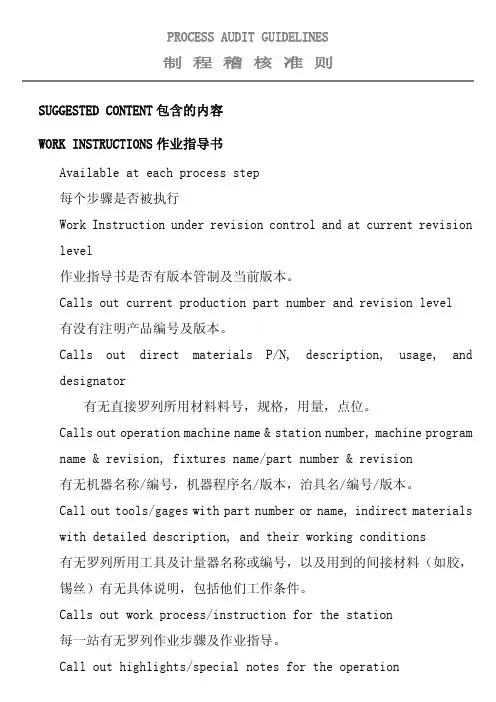
PROCESS AUDIT GUIDELINES制 程 稽 核 准 则SUGGESTED CONTENT包含的内容WORK INSTRUCTIONS作业指导书Available at each process step每个步骤是否被执行Work Instruction under revision control and at current revision level作业指导书是否有版本管制及当前版本。
Calls out current production part number and revision level有没有注明产品编号及版本。
Calls out direct materials P/N, description, usage, and designator有无直接罗列所用材料料号,规格,用量,点位。
Calls out operation machine name & station number, machine program name & revision, fixtures name/part number & revision有无机器名称/编号,机器程序名/版本,治具名/编号/版本。
Call out tools/gages with part number or name, indirect materials with detailed description, and their working conditions有无罗列所用工具及计量器名称或编号,以及用到的间接材料(如胶,锡丝)有无具体说明,包括他们工作条件。
Calls out work process/instruction for the station每一站有无罗列作业步骤及作业指导。
Call out highlights/special notes for the operation在作业指导书中有没有对相关注意事项做重点标识。
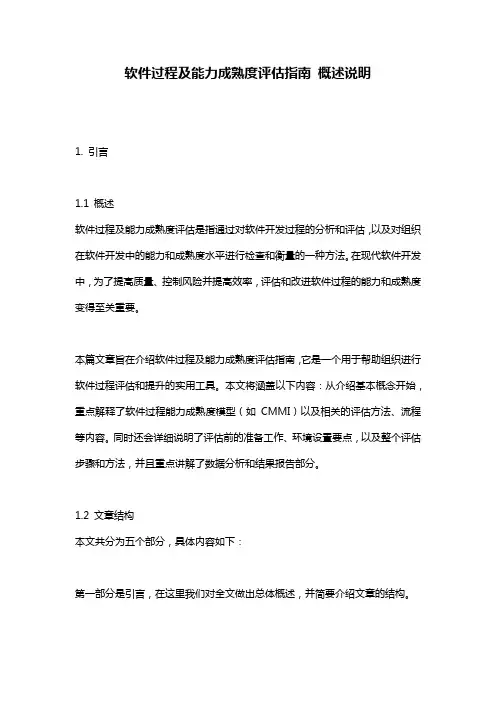
软件过程及能力成熟度评估指南概述说明1. 引言1.1 概述软件过程及能力成熟度评估是指通过对软件开发过程的分析和评估,以及对组织在软件开发中的能力和成熟度水平进行检查和衡量的一种方法。
在现代软件开发中,为了提高质量、控制风险并提高效率,评估和改进软件过程的能力和成熟度变得至关重要。
本篇文章旨在介绍软件过程及能力成熟度评估指南,它是一个用于帮助组织进行软件过程评估和提升的实用工具。
本文将涵盖以下内容:从介绍基本概念开始,重点解释了软件过程能力成熟度模型(如CMMI)以及相关的评估方法、流程等内容。
同时还会详细说明了评估前的准备工作、环境设置要点,以及整个评估步骤和方法,并且重点讲解了数据分析和结果报告部分。
1.2 文章结构本文共分为五个部分,具体内容如下:第一部分是引言,在这里我们对全文做出总体概述,并简要介绍文章的结构。
第二部分是关于软件过程能力成熟度评估的概念,我们将介绍软件过程能力成熟度模型以及评估的重要性和优势与应用场景。
第三部分是关于软件过程模型(例如CMMI)的介绍,我们将详细解释CMMI 的基本原则和结构,并说明五个成熟度级别的含义和要点。
此外,我们还会介绍CMMI评估方法及流程,帮助读者更好地理解和应用这一评估模型。
第四部分是对软件过程能力成熟度评估指南进行详解。
在这一部分中,我们将拓展论述评估前的准备工作和环境设置要点,接着详细介绍评估步骤和方法,并且通过实例讲解数据分析和结果报告要点。
最后一部分是结论及展望,在这一部分中我们将总结软件过程能力成熟度评估对软件开发的影响,并探讨未来发展方向,并以结束语作为全文的收尾。
1.3 目的本文旨在帮助读者全面理解软件过程及能力成熟度评估指南,并能够应用该指南进行有效的软件过程能力和成熟度评估。
通过评估和提升软件过程的能力和成熟度,组织能够更好地控制风险、提高产品质量和开发效率,并在竞争激烈的市场中取得可持续发展的优势。
2. 软件过程能力成熟度评估概念:2.1 软件过程能力成熟度模型介绍在软件开发领域,软件过程能力成熟度模型(Software Process Capability Maturity Model,简称SP-CMM或CMM)是一种用于评估组织的软件开发和管理能力的模型。
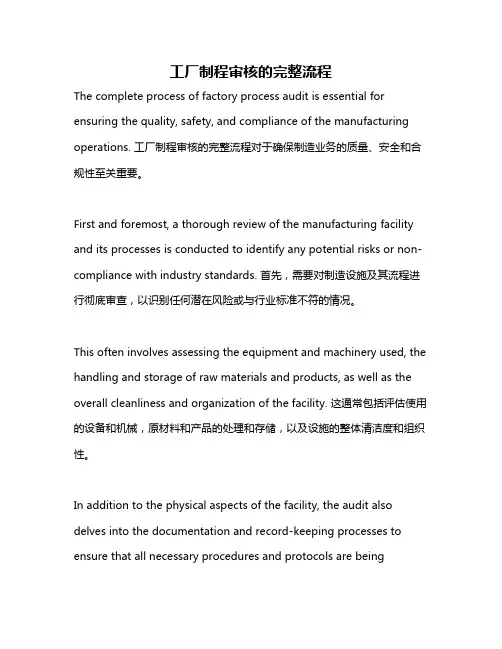
工厂制程审核的完整流程The complete process of factory process audit is essential for ensuring the quality, safety, and compliance of the manufacturing operations. 工厂制程审核的完整流程对于确保制造业务的质量、安全和合规性至关重要。
First and foremost, a thorough review of the manufacturing facility and its processes is conducted to identify any potential risks or non-compliance with industry standards. 首先,需要对制造设施及其流程进行彻底审查,以识别任何潜在风险或与行业标准不符的情况。
This often involves assessing the equipment and machinery used, the handling and storage of raw materials and products, as well as the overall cleanliness and organization of the facility. 这通常包括评估使用的设备和机械,原材料和产品的处理和存储,以及设施的整体清洁度和组织性。
In addition to the physical aspects of the facility, the audit also delves into the documentation and record-keeping processes to ensure that all necessary procedures and protocols are beingfollowed and documented appropriately. 除了设施的物理方面,审核还涉及文档和记录保存流程,以确保所有必要的程序和协议得到适当的遵循和记录。
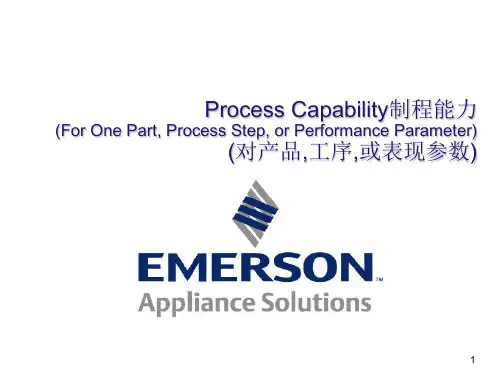
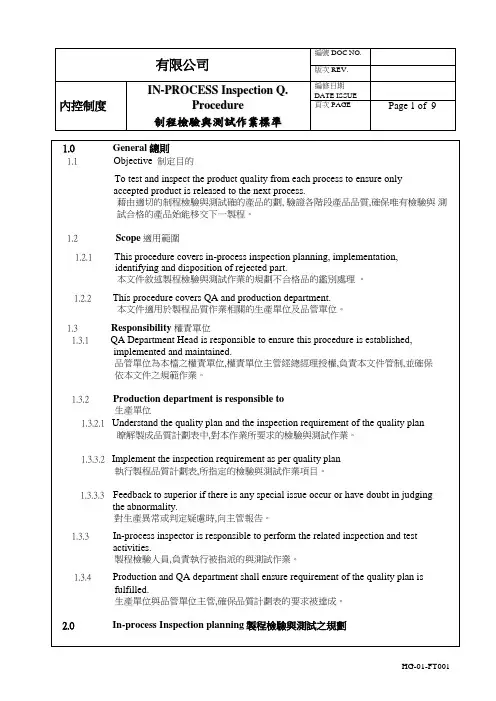
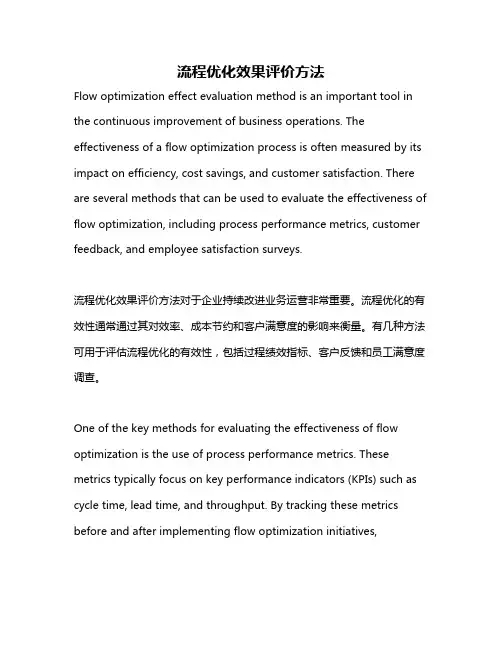
流程优化效果评价方法Flow optimization effect evaluation method is an important tool in the continuous improvement of business operations. The effectiveness of a flow optimization process is often measured by its impact on efficiency, cost savings, and customer satisfaction. There are several methods that can be used to evaluate the effectiveness of flow optimization, including process performance metrics, customer feedback, and employee satisfaction surveys.流程优化效果评价方法对于企业持续改进业务运营非常重要。
流程优化的有效性通常通过其对效率、成本节约和客户满意度的影响来衡量。
有几种方法可用于评估流程优化的有效性,包括过程绩效指标、客户反馈和员工满意度调查。
One of the key methods for evaluating the effectiveness of flow optimization is the use of process performance metrics. These metrics typically focus on key performance indicators (KPIs) such as cycle time, lead time, and throughput. By tracking these metrics before and after implementing flow optimization initiatives,organizations can assess the impact of the changes on the overall efficiency and productivity of their operations.评估流程优化效果的关键方法之一是使用过程绩效指标。
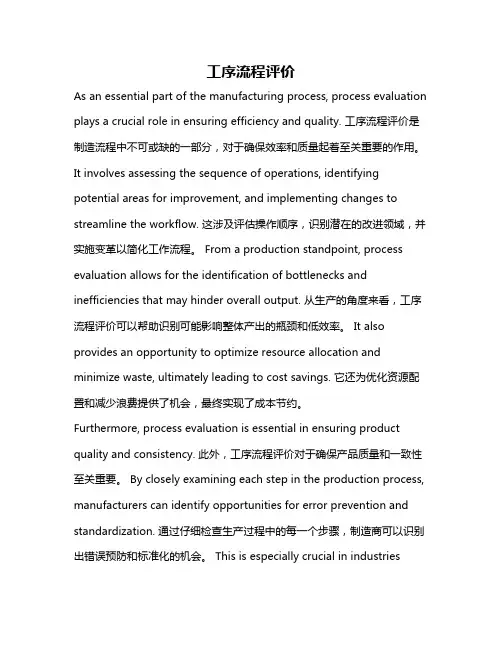
工序流程评价As an essential part of the manufacturing process, process evaluation plays a crucial role in ensuring efficiency and quality. 工序流程评价是制造流程中不可或缺的一部分,对于确保效率和质量起着至关重要的作用。
It involves assessing the sequence of operations, identifying potential areas for improvement, and implementing changes to streamline the workflow. 这涉及评估操作顺序,识别潜在的改进领域,并实施变革以简化工作流程。
From a production standpoint, process evaluation allows for the identification of bottlenecks and inefficiencies that may hinder overall output. 从生产的角度来看,工序流程评价可以帮助识别可能影响整体产出的瓶颈和低效率。
It also provides an opportunity to optimize resource allocation and minimize waste, ultimately leading to cost savings. 它还为优化资源配置和减少浪费提供了机会,最终实现了成本节约。
Furthermore, process evaluation is essential in ensuring product quality and consistency. 此外,工序流程评价对于确保产品质量和一致性至关重要。
By closely examining each step in the production process, manufacturers can identify opportunities for error prevention and standardization. 通过仔细检查生产过程中的每一个步骤,制造商可以识别出错误预防和标准化的机会。
工艺流程的评价标准英文回答:Evaluation criteria for process flow can vary depending on the specific industry and context. However, there are some common factors that can be considered when evaluatinga process flow. These factors include efficiency, effectiveness, flexibility, reliability, and sustainability.Efficiency refers to how well the process flow utilizes resources, such as time, manpower, and materials. A process flow that minimizes waste and maximizes output isconsidered efficient. For example, in a manufacturing process, a well-designed process flow can minimize the time required for each step, reduce the number of defects, and optimize the use of raw materials.Effectiveness measures the ability of the process flowto achieve its intended objectives. A process flow that consistently delivers high-quality products or services isconsidered effective. For instance, in a customer service process flow, effectiveness can be assessed by the abilityto resolve customer issues quickly and satisfactorily.Flexibility refers to the adaptability of the process flow to changes in demand, technology, or market conditions.A flexible process flow can easily accommodate variationsin input or output requirements. For example, in a supply chain process flow, flexibility can be evaluated by the ability to quickly adjust production or distribution plansin response to changes in customer demand.Reliability assesses the consistency and predictability of the process flow. A reliable process flow delivers consistent results and minimizes the occurrence of errorsor failures. For instance, in a software developmentprocess flow, reliability can be measured by the ability to consistently deliver bug-free software releases on time.Sustainability evaluates the environmental and social impact of the process flow. A sustainable process flow minimizes negative impacts on the environment and societywhile maximizing positive contributions. For example, in a manufacturing process flow, sustainability can be assessed by the use of eco-friendly materials, energy-efficient equipment, and responsible waste management practices.In conclusion, when evaluating a process flow, it is important to consider factors such as efficiency, effectiveness, flexibility, reliability, and sustainability. By assessing these criteria, organizations can identify areas for improvement and make informed decisions to optimize their process flows.中文回答:工艺流程的评价标准可以根据具体行业和环境的不同而有所差异。
工艺流程的评价方法Evaluating a manufacturing process is crucial for ensuring high-quality products and efficient production. 工艺流程的评价对于确保产品质量和生产效率至关重要。
Therefore, having a reliable and accurate evaluation method is essential for manufacturers to make informed decisions and improvements. 因此,拥有一种可靠而准确的评价方法对于制造商做出明智的决策和改进至关重要。
One common method of evaluating a manufacturing process is through performance metrics such as cycle time, defect rate, and yield. 评估制造过程的一种常见方法是通过性能指标,如生产周期、缺陷率和产量。
These metrics provide quantitative data on how well a process is performing and where potential issues may lie. 这些指标提供了有关生产过程表现如何以及潜在问题所在的定量数据。
In addition to performance metrics, manufacturers may also use qualitative assessments to evaluate a manufacturing process. 除了性能指标,制造商还可以使用定性评估来评价制造过程。
Qualitative assessments involve gathering feedback from employees, observing the process first-hand, and analyzing any subjective factors that mayimpact the process's performance. 定性评估涉及收集员工的反馈意见,亲自观察过程,并分析可能影响过程表现的主观因素。
评估提速流程Evaluating the process of increasing speed in a system or workflow is crucial for ensuring efficiency and productivity. 评估提速流程对于确保效率和生产力至关重要。
By analyzing each step of the process, we can identify areas that need improvement and implement changes to optimize performance. 通过分析流程的每个步骤,我们可以找出需要改进的地方,并实施变革以优化绩效。
One key aspect of evaluating the speed-up process is to consider the impact on overall productivity and the quality of the final output. 评估提速流程的一个关键方面是考虑对整体生产力和最终产出质量的影响。
It is important to strike a balance between speed and accuracy to ensure that efficiency is not compromised by sacrificing quality. 在速度和准确性之间取得平衡至关重要,以确保效率不会因为牺牲质量而受损。
Additionally, involving stakeholders and team members in the evaluation process can provide valuable insights and perspectives for making informed decisions. 此外,让利益相关方和团队成员参与评估过程可以为做出明智的决策提供宝贵的见解和观点。
工艺名词解释工艺是一种创造性的活动,它涉及到人类利用各种材料和工具,按照一定的方法和规则,制作出具有实用价值或美学价值的物品。
工艺品可以是日常用品,也可以是艺术品,它们反映了人类的智慧和文化。
在工艺的过程中,有许多专业的名词需要了解和掌握,下面就对一些常见的工艺名词进行解释。
工艺品工艺品(craftwork)是指用手工或机械加工方式,以自然材料或人造材料为原料,制作出具有实用功能或装饰功能的物品。
工艺品通常具有一定的地域特色、民族风格或历史文化内涵,它们可以是民间传统的手工艺品,也可以是现代创新的设计品。
工艺流程工艺流程(process flow)是指工业品生产中,从原料到制成成品各项工序安排的程序。
工艺流程要求合理、科学、经济,能够保证产品的质量和效率。
工艺流程一般包括以下几个方面:原料准备、加工、组装、检验、包装等。
工艺装备工艺装备(process equipment)简称“工装”,是指为实现工艺规程所需的各种刃具、夹具、量具、模具、辅具、工位器具等的总称。
使用工艺装备的目的有以下几种:有的是为了制造产品所必不可少的,有的是为了保证加工的质量,有的是为了提高劳动生产率,有的则是为了改善劳动条件。
工艺参数工艺参数(process parameter)是指影响产品质量和生产效率的各种可控制的因素,如温度、压力、速度、时间、浓度等。
工艺参数要根据产品的性能要求和生产条件进行选择和调整,以达到最佳的效果。
工艺设计工艺设计(process design)是指根据产品图纸和技术要求,确定产品的制造方法、加工顺序、设备选择、刀具选用、加工参数等,并编制出相应的技术文件和图表的过程。
工艺设计要求合理、可行、经济,能够满足产品质量和生产效率的要求。
工艺评价工艺评价(process evaluation)是指对已有或拟定的工艺方案进行分析和比较,以确定其优劣和改进方向的过程。
工艺评价要考虑多方面的因素,如产品质量、生产成本、资源消耗、环境影响等,并采用科学的方法和标准进行量化或定性地评价。
制程能力的评价(DOC 8页)製程能力的評價製程能力與規格之比較,可就製程平均值與規格中心及分散寬度與規格容許範圍兩方面比較,亦可直接計算超出規格的不良率來表示。
將製程能力與規格之比較用簡單的數字及等級評定的方法,謂之製程能力評價。
工程準確度指數(Capability of Accuracy)的評價設定工程規格中心值的目的,在於希望該工程製造出來的各種產品的實績值,能以規格中心為中心,成左右對稱的常態分配,而製造時也應以規格中心值為目標。
工程準確度平價之目的就在於衡量製程平均與規格中心之一制程度,有時工程準確度指數又稱為正確度指數。
(1)K的計算製程平均值()與規格中心值之間偏差程度,稱為工程準確度,其指數K之計算公式如下:T=Su-Sl=規格上限-規格下限由上是可知當M與差愈小,也就是品質接近規格要求的水準。
K值為負時,表示實績值偏低,K值為正時表示偏高。
在單邊規格的情形,即只有規格上限Su或只有規格下限Sl的情形,因沒有規格中心值,故不能計算工程準確度指數。
(2)K之等級評定K等級評定標準等級值ABC25%D(3)等級評定後之處置原則•A級:作業員遵守作業標準操作,繼續維持。
•B級:有必要時盡可能改善為A級。
•C級:作業員可能看錯規格,不按作業標準操作,須加強訓練,檢討規格及作業標準。
•D級:應採取緊急措施,全面檢討所有可能影響的因素,必要時得停止生產。
K不良時其對策方法以製造單位為主技術單位為副品管單位為輔有時又以Ca表之。
工程能力指數Cp(Capability of Process)之評價設定工程上下限的目的,在於希望製造出來的各個產品之特性值,能在規格上下限之容許範圍內。
工程能力的評價之目的就在於衡量產品分散寬度符合公差的程度。
工程能力指數又可稱為工程精密度指數(capability of Precision)(1)Cp之計算由上式可知產品分散寬度愈大時,Cp值愈小,表示製程能力差,反之表示能力好。
定制类的电子产品评估流程(中英文版)Title: Customized Electronic Products Evaluation ProcessTitle: 定制类电子产品评估流程Introduction:Evaluation of customized electronic products is a crucial step in ensuring their quality, performance, and safety.This document outlines the evaluation process, which includes various stages and criteria to assess different aspects of the products.引言:定制类电子产品的评估是确保其质量、性能和安全的重要步骤。
本文档概述了评估流程,包括各种阶段和标准,以评估产品的不同方面。
Stage 1: Product Specification ReviewThe first stage involves a thorough review of the product specifications provided by the client.This includes understanding the functionality, technical requirements, and any specific standards that need to be met.阶段一:产品规格书评审第一阶段涉及对客户提供的产品规格书的彻底审查。
这包括理解功能、技术要求和需要满足的任何特定标准。
阶段二:初步设计与方案评审Once the specifications are clear, the next step is to evaluate thepreliminary design and solution proposed by the manufacturer.This assessment focuses on the feasibility, cost-effectiveness, and alignment with the client"s requirements.阶段二:初步设计与方案评审一旦规格明确,下一个步骤是评估制造商提出的初步设计和解决方案。
Prozessschritt- EvaluierungCompany/公司名称FirmaContact Person/联系人Ansprechpartner Audit Number/ 稽核编号Audit-Ident:MP/0005/99Product or Product Range Produkt oder Produktspektrum Auditors/稽核人AuditorenProcess Step Name Prozessschritt-Titel Process Step No. Prozessschritt-Nr.:No. Nr. Question ItemFragestellungRemarks and Attachment ListBemerkung und AnlagenvermerkeScorePunktePart A Product Development ProcessTeil A ProduktentstehungsprozessA-1 Product Development Planning/产品开发计划A-1 Planung der Produktentwicklung1.1 Are the customer requirements available?/是否具备客户的需求1.2 Is a product development plan available and are thetargets maintained?/是否具备一个产品开发计划,并且其目标是否获得确保?1.3 Are the resources for the realization of the productdevelopment planned?是否已规划实现产品开发所需之相关资源?1.4 Have the product requirements been determinedand considered?是否已考虑并确定产品相关需求?1.5 Has the feasibility been determined based on theavailable requirements?/是否根据相关已知需求确定其可行性?1.6 Are the necessary personnel and technicalconditions for the project process planned/available?是否具备为这个项目处理计划提供必要的人员和技术?A-2 Realizing Product Development/产品开发实现A-2 Realisierung der Produktentwicklung2.1 Is the design FMEA raised and are improvementmeasures established?是否有制定设计FMEA并且建立相关改进措施?2.2 Is the design FMEA updated in the project processand are the established measures realized?在项目执行过程中, 是否修订设计FEMA,并且已经建立的措施都已被了解?2.3 Is a quality plan prepared?是否有具备质量计划?2.4 Are the required releases/ qualification recordsavailable at the respective times?各阶段所需之放行/认可之纪录是否都具备?Prozessschritt- Evaluierung2.5 Are the required resources available?所需之资源是否都具备?A-3 Process Development Planning/过程发展计划A-3 Planung der Prozessentwicklung3.1 Are the product requirements available?产品要求是否已具备?3.2 Is a process development plan available and are thetargets maintained?一个过程开发计划是否具备,并且目标都得以确保?3.3 Are the resources for the realization of serialproduction planned?是否已规划实现连续生产所需之资源?3.4 Have the process requirements been determinedand considered?是否确定并且考虑制程相关要求?3.5 Are the necessary personnel and technicalpreconditions for the project process planned/available?这个项目过程所需之人员和技术能力是否都具备?3.6 Is the process FMEA raised and are improvementmeasures established?是否制定制程FMEA,并且建立相关改进措施?A-4 Realizing Process DevelopmentA-4 Realisierung der Prozessentwicklung4.1 Is the process FMEA updated when amendmentsare made during the project process and are theestablished measures implemented?在项目执行过程中, 当有改善行动时, 制程FEMA是否相应修订, 并且建立的措施是否被导入实施?4.2 Is a quality plan prepared?是否制定质量计划?4.3 Are the required releases/ qualification recordsavailable at the respective times?各阶段所需之放行/认可之纪录是否都具备?4.4 Is a pre-production carried out under serialconditions for the serial release?是否有针对连续性生产设定之各项条件下进行试产?4.5 Are the production and inspection documentsavailable and complete?生产和检验文件是否具备并完善?4.6 Are the required resources available?需求的资源是可否具备?Part B Serial ProductionTeil B SerienproduktionB-5 Suppliers/ Input MaterialB-5 Zulieferanten/ Vormaterial5.1 Are only approved quality capable suppliers used?是否仅仅使用具备质量能力之合格供货商?5.2 Is the agreed quality of the purchased partsguaranteed?所采购之零件是否确认符合所认定之质量?Prozessschritt- Evaluierung5.3 Is the quality performance evaluated and arecorrective actions introduced when there aredeviations from the requirements?是否评价供货商之质量绩效,并供货商供货不符合要求时,是否采取矫正措施?5.4 Are target agreements for continual improvement ofproducts and process made and implemented withthe suppliers?为达成产品/制程持续改善之目标,是否已经与供货商取得协议并已经导入实施?5.5 Are the required releases for the delivered serialproducts available and the required improvementmeasures implemented?针对连续产出之成品之放行程序是否具备?并且所需之改善措施是否已导入实施?5.6 Are the procedures agreed with the customer,regarding customer-supplied products, maintained?是否具备获得客户同意, 有关于客供料管理之相关程序?5.7Are the stock levels of input material matched toproduction needs?进料库存水平是否匹配产能之需求?5.8Are input materials/ internal residues delivered andstored according to their purpose?是否依据实际需求目的运送与储存外部进料与内部余料?5.9Is the personnel qualified for the respective tasks?各别工站之人员是否经过认证?B-6 ProductionB-6 ProduktionB-6.1 Personnel/ QualificationQualifikationB-6.1 Personal/6.1.1 Are the employees given responsibility and authorityfor monitoring the product/ process quality?员工是否被充分授与权责以监控产品/制程质量?6.1.2 Are the employees given responsibility and authorityfor production equipment and environment?员工是否被充分授与权责以维护生产设备和环境?6.1.3 Are the employees suitable to perform the requiredtasks and is their qualification maintained?/员工是否适合执行所指派之工作, 并且其认可纪录是是否保存?6.1.4 Is there a personnel plan with a replacement ruling?是否有员工更换准则之计划?6.1.5 Are instruments to increase employee motivationeffectively implemented?是否有效地导入可激励员工士气之设备?B-6 ProductionB-6 ProduktionB-6.2 Production Material/ EquipmentEinrichtungenB-6.2 Betriebsmittel/6.2.1 Are the product specific quality requirements fulfilledwith the production equipment/ tools?如何利用制造工具满足产品特定质量要求。